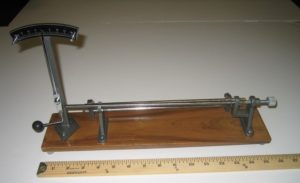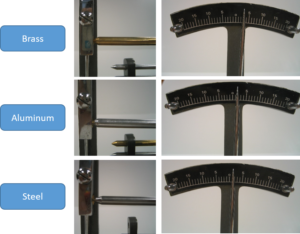Model Description
This physical model demonstrates thermal expansion for different metals. This demonstration should take 10-15 minutes.

Engineering Principle
When materials, especially metals, are exposed to heat, they expand at different rates. The reverse is also true in that cold temperatures tend to cause material contraction. The amount of expansion/contraction may be small, but if not taken into account in the design of structures and/or machine parts, the resulting expansion/contraction could result in excessive strain/stress.
What You Need
| Item | Quantity | Description/Clarification |
|---|---|---|
| Pyrometer | 1 | This is the apparatus used to demonstrate how metals expand with heat. The entire apparatus is about 16 inches long. |
| Candles | 3 | Small candles are used to heat up the metals. The pyrometer calls for only one candle; however, the resulting change and time to see the change in the steel was excessive. Three candles were ideal to create perceptible change in a reasonable amount of time. |
| Lighter or matches | 1 | A lighter or matches is necessary to light the candles. |
| Supports | As needed | The magnets raised the candles closer to the rods to increase the amount of heat applied to the metal rods. |
| Metal Rods | 3 | Three types of metal rods are part of the kit used to show different expansion rates: brass, steel, and aluminum. |
How It’s Done
Before Class: Test the apparatus to see that it works properly with the equipment used. Be sure that it is safe to use a candle flame in class.
In Class: Set up the apparatus (figure below, top) and begin to explain how heat affects materials by making them expand. Show the class the three rods and ask which they think will expand most. Put the first rod in the apparatus, set the measurement to zero using the screw on the right-hand side (figure below, bottom left), and place the lit candles underneath the rod (figure below, bottom right).

In any order, heat up each of the rods for about 10 minutes and make a note of how much the length of each changed. This experiment can be occurring while you are presenting the theory associated with thermal expansion. The students should see the brass expanding the most, then the aluminum, and the steel expands least.

Additional Application: Using the results of the demonstration, the professor can lead a discussion on the proper selection of materials and how designers plan for associated expansion/contraction. Some examples are the use of expansion joints in bridges and buildings, tolerances in engine parts, steel vs brass (can select any types of materials for comparison) for a material type to decrease the amount of expansion/contraction associated with temperature.

I have built a similar apparatus for discussion and am trying to find the calculations to support the theory ifyou can help.